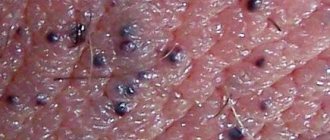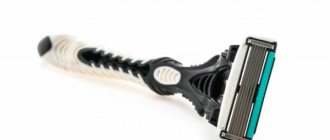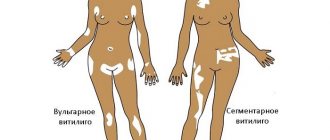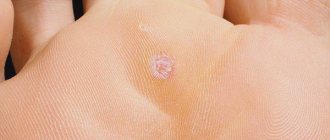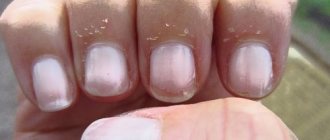A rather unpleasant phenomenon that every woman has encountered is cracks in the labia. They can appear due to many factors. To quickly deal with them, you first need to find out the cause. After determining the cause, the doctor prescribes treatment. Most often this is medicinal, but there are cases when surgery may be prescribed. Traditional recipes can also help you in the fight against cracks in the labia, but only if they are recommended by a doctor.
It is important to start treating this phenomenon in time to avoid consequences. If the cracks bother you for a long time, then it is too late to self-medicate, you need to urgently run to the doctor.
Cracks on the labia
Cracks on the labia are a violation of the integrity of the mucous membrane. This disorder can be caused by various factors and is accompanied by various unpleasant sensations, especially when urinating or during contact.
The main symptoms of cracks in the labia: itching, burning sensation and hyperemia. Other symptoms may also occur.
Cracks in the labia minora and majora are not a separate disease. They occur as a result of a malfunction of the body or as a result of other infections.
If they appear, you need to consult a doctor as soon as possible to determine the cause and choose the right treatment. With timely treatment, all unpleasant symptoms disappear very quickly. If treatment is delayed, the cracks may become calloused. In this case, it will be much more difficult to cure them.
What are microcracks?
Cracks in the intimate area are not an independent pathology, but arise in response to a deterioration in the body’s condition or due to various infections. To establish the exact cause, it is necessary to seek medical help as soon as possible and establish an accurate diagnosis.
Waiting in these cases is contraindicated - small injuries can serve as a channel for pathogenic microbes to enter the woman’s body.
Microcracks are divided into the following types:
- Acute - the main signs: they appeared relatively recently and have pronounced pain symptoms in a certain area. Painful sensations occur when touching the damaged area.
- Chronic - characterized by long-term occurrence and scarring and thickening of the edges. They cause lasting pain even without touching them. Occurs in a sitting position. They have a very unpleasant appearance.
Types of microcracks in the labia
Microcracks in the mucous membranes of the labia are divided into two types: acute and chronic.
Expert opinion Sakania Luiza Ruslanovna
Dermatovenerologist, cosmetologist, trichologist
Ask a Question
Acute microcracks are those that have appeared recently and cause intense pain in a certain area upon contact.
Chronic are those microcracks that appeared a long time ago and turned into calluses. They can be compacted around the edges and cause severe pain even without contact.
Forms and causes of vulvitis
Inflammation occurs both in adulthood and in girls under 10 years of age against the background of frequent acute respiratory viral infections, reduced immunity, pinworm infection and antibiotic use. At risk are pregnant girls, women with menopausal syndrome, whose mucous membranes become thinner due to decreased estrogen production. Symptoms of vulvitis appear from infection with pathogenic microorganisms (Trichomonas, chlamydia) or from an increase in one’s own opportunistic flora (fungi, herpes viruses, E. coli).
There are vulvitis:
- primary – an independent disease;
- secondary – a consequence of other diseases.
The main causes of primary vulvitis:
- genital injuries;
- intestinal dysbiosis;
- tight, synthetic underwear;
- using sanitary pads without changing for a long time;
- insufficient personal hygiene.
Secondary vulvitis occurs against the background of:
- infections, inflammations of the genitourinary system – colpitis, vaginitis, cervicitis and others;
- changes in the vaginal microflora due to long-term self-medication with antibiotics;
- disruptions in the functioning of the endocrine system (diabetes mellitus, adrenal gland diseases);
- infection with worms and other parasites (symptoms worsen at night when roundworms or pinworms emerge from the anus);
- vitamin deficiency;
- immunodeficiency.
Depending on the main provoking factor, several forms of the disease are distinguished:
- Bacterial vulvitis. The cause of inflammation is opportunistic microorganisms or infections. There is a distinction between nonspecific vulvitis, caused by an imbalance of microflora, and a specific form, which develops when infected with an infection from a sexual partner. Among the most aggressive pathogens are gonococci, chlamydia, trichomonas;
- Allergic vulvitis. Inflammation is caused by contact with an allergen, for example, when particles of washing powder are not completely rinsed out of the laundry, or a gel with fragrances is used for intimate hygiene;
- Candidiasis (fungal) vulvitis. The causative agent of the disease is fungi of the genus Candida. Candidiasis vulvitis more often than others becomes chronic. An exacerbation can be triggered by any factors: from stress to a cold. Candidiasis (fungal vulvitis) is also classified as nonspecific inflammation;
- Atrophic vulvitis. The disease develops during natural changes in the tissues of the internal genital organs during menopause. Atrophic processes can begin after removal of the ovaries.
Vulvitis occurs acutely and chronically. In the acute form, the symptoms of the disease appear suddenly and quickly intensify, increasing over 2-3 days. During this period, it is important to consult a doctor, undergo a diagnosis of vulvitis and receive quality treatment. The risk of relapse will be minimal.
If acute vulvitis is treated incorrectly or if the doctor’s recommendations are not followed, the inflammation will become chronic. Symptoms will subside and reappear, reducing quality of life. Even a young girl can become a regular gynecology patient if she ignores the signs of the disease.
There is also subacute vulvitis - a transitional form of inflammation.
Causes of cracks in the labia area
Cracks in the mucous membrane of the labia can occur due to exposure to various external or internal factors.
External factors include: mechanical damage, violations of personal hygiene rules and the use of low-quality underwear. Internal factors influencing the formation of microcracks in the mucous membranes are medications and various diseases.
External factors
As mentioned above, sometimes the cause of painful cracks on the labia is aggressive external influences.
Expert opinion
Sakania Luiza Ruslanovna
Dermatovenerologist, cosmetologist, trichologist
Ask a Question
Accordingly, if they are eliminated, the problem is quickly resolved without medical help.
For example:
- Microcracks due to violation of basic hygiene standards. Various contaminants: intense sweating, copious vaginal discharge and drops of urine can cause the formation of microcracks on the labia. In this case, careful body care will help the fair sex cope with them. Excessive enthusiasm for “bath” procedures can lead to the same result as insufficient self-care. In this case, it means, first of all, an excessive passion for cosmetics: soap, shower gels, foam or bath salts, aromatic wet wipes, powder, deodorants, etc. Accordingly, to eliminate cracks in the mucous membranes, it may be enough to simply stop using cosmetics and household chemicals.
- Microcracks due to the use of synthetic underwear. In some cases, cracks in the labia majora can be caused by wearing low-quality underwear (nylon, chemically treated, etc.). Inflammation occurs due to impaired breathing of the skin. Microcracks are a consequence of this inflammation. Thus, abandoning synthetic materials in favor of high-quality natural undyed fabrics will help quickly get rid of the problem. Nowadays, in specialized stores you can find a lot of high-quality and beautiful underwear, which in appearance is in no way inferior to synthetic panties. But in the future, the fan of natural things will definitely not have any health problems.
- Mechanical damage. Sometimes microcracks on the external genitalia appear after sex. The reason for this may be an allergic reaction to latex, any lubricants, etc. Alternating anal and vaginal sex in one sexual act can also cause the formation of cracks. The reason for this is microorganisms that penetrated from the intestines. Another example of mechanical damage is rupture during childbirth. To prevent the formation of cracks in the external genitalia after childbirth, as early as the ninth month of pregnancy, women are recommended to begin massaging the perineum. It allows you to slightly stretch and strengthen the skin and muscles, thereby preventing mechanical disorders. But remember that this must be agreed upon with the doctor in advance.
Internal factors
Cracks in the genitals caused by internal factors require medical intervention and longer treatment.
In order to get rid of such microtraumas, it is necessary to diagnose and eliminate the main cause of their occurrence: stop taking “harmful” medications, stop the inflammatory process or cure the disease.
- Cracks caused by the use of medications. Cracks in the mucous membrane of the labia sometimes appear as a result of oral administration of drugs or the use of local drugs. Ointments and gels for external use can cause an acute allergic reaction and provoke the formation of microcracks. Ingestion of certain hormonal and antibacterial drugs, medications for the treatment of human papillomavirus, as well as other medications or herbal extracts (for example, the active use of tea tree oil) can all cause cracks in the labia. Stopping or changing medications may help relieve painful fissures in a woman's genitals.
- Cracks in the genital organs caused by diseases Hormonal disorders are considered the most common cause of the formation of cracks in the mucous membrane of the genital organs. For example, estrogen deficiency (often observed during menopause) provokes excessive dryness of the skin, which results in microtraumas. The cause of the formation of microcracks on the labia may be lichen. It is localized to various parts of the body, but most often affects the arms, legs and groin. The formation of microcracks in the skin and mucous membranes is one of the characteristic symptoms of this disease. The cause of the formation of microcracks on the labia may be a disease of the endocrine system. Another cause of microcracks on the labia may be thrush. Other common causes of this phenomenon include: other fungal and infectious diseases, vitamin deficiency, helminthic infestation, eczema, allergies, etc.
- Physiology. Separately, it is worth mentioning the natural physiological processes that provoke cracks in a woman’s genitals. For example, an increase in the number of candida fungi, which contribute to the disruption of the integrity of the mucous membranes, is activated during hormonal changes: during pregnancy or simply during menstruation. And therefore, it is during this period that cracks may appear on the labia.
External reasons for the appearance
Foreign factors are safe for health. After identifying the main cause of irritation of the vaginal mucosa, its solution, the cracks go away on their own, without special treatment.
Third-party reasons include the following:
- Mechanical injuries to the labia - often serious injuries to the labia minora and vaginal mucosa appear after childbirth and abortion. Cracks may also appear as a result of harsh sexual contact, inaccurate depilation of the skin, or damage due to exposure to latex.
- Incorrect and untimely personal hygiene of the body - infrequent washing leads to the accumulation of discharge and urine residues between the labia in women. This causes bacteria to multiply, irritate delicate skin and lead to cracks.
- Wearing tight underwear made of synthetic materials - artificial fabrics impede the penetration of oxygen. As a result, the skin of the labia does not breathe, which causes microcracks to appear. A similar situation is sometimes observed with panty liners or tampons.
- Excessive use of cosmetics - constant use of intimate hygiene gels, creams and other scented products leads to dry skin. This invariably causes irritation and cracks on the labia.
What types of cracks are there?
There are two main types of pathology: chronic and acute cracks. The first ones appeared in women a long time ago, but there was no treatment, so the wounds became calloused. They cause pain even if you don't touch them.
Sharp cracks are microtraumas that have appeared recently. They cause discomfort when touched. Pathology indicates the onset of an inflammatory process in the body.
How is diagnostics carried out?
To find the reason for the appearance of cracks on a woman’s labia, it is necessary not only to conduct an external examination, but also to do a series of laboratory tests:
- examination for urogenital infections;
- vaginal culture;
- general blood analysis;
- blood test for hepatitis;
- blood for sugar;
- blood for HIV;
- examination of stool for the presence of worms and others.
Only after a thorough examination and diagnostics, the doctor will be able to find the factor that provoked the appearance of cracks and select effective therapy.
Solutions to the problem
When cracks appear, it is important not only to cure the damage, but to identify the cause of its occurrence. If this is not done, the problem will return again and again. First, you should review your hygiene methods, minimize the use of products with fragrances and start washing with clean water. In case of allergies or irritation, the defects will disappear quickly.
It won't hurt to adjust your diet. If you reduce your consumption of salty, spicy, smoked foods and alcohol and eat more vegetables, fruits, lean meat and fish, your skin condition will noticeably improve. When taking medications, you should check with your doctor to see if they can cause cracks. If the answer is yes, you need to ask him to change the treatment plan.
You cannot ignore the problem or try to get rid of it on your own. There is a risk of missing a dangerous disease or getting rid of external manifestations by driving the pathology inside.
Drug treatment
If microtraumas appear, you should consult a gynecologist. The doctor will conduct an examination, collect a medical history and give directions for the necessary tests. Usually it is required to take a general blood and urine test, bacterial culture for vaginal microflora and tests for the presence of sexually transmitted infections.
Expert opinion
Sakania Luiza Ruslanovna
Dermatovenerologist, cosmetologist, trichologist
Ask a Question
After receiving the results, the doctor will make a diagnosis and prescribe treatment.
Therapy depends on the specific disease and what pathogens it is caused by. For viral infections, antiviral drugs are prescribed. Most sexually transmitted diseases are caused by bacteria.
They are most sensitive to penicillin, cephalosporin and macrolide antibiotics. If the cracks are caused by vaginal candidiasis or other fungal diseases, then it is advisable to take antifungal drugs.
Along with taking the main active medications, it is recommended to take probiotics, immunomodulators and vitamins.
Diagnosis of the problem and treatment
To diagnose this disease, the patient is examined. The doctor also records the woman’s complaints to complete the picture of the disease. After this, tests are prescribed and the necessary smears are given.
Treatment with medications is performed to block the unpleasant symptoms of the disease and eliminate the main causative agents of the disease. In most cases, treatment ends with conservative means, but it also happens that the patient needs surgery. It can be performed under either general or local anesthesia.
Therapy with folk remedies
It is worth understanding here that it is not recommended to resort to this method on your own. In addition, doing it yourself is not easy.
In any case, without knowing the cause, treatment will not bring visible results. But you can relieve unpleasant symptoms before visiting a doctor using this method. For example, using warm baths with medicinal herbs.
Traditional treatment and prevention of cracks includes:
- genital hygiene;
- strengthening the body;
- medicinal baths or compresses based on decoctions of medicinal herbs;
- use of boromenthol ointment;
- getting rid of unpleasant odor.
Calendula tincture is most often used to relieve symptoms of the disease.
Home methods
You can relieve inflammation and cure cracks in the labia majora using folk methods.
But they must be agreed with the attending physician. Expert opinion
Sakania Luiza Ruslanovna
Dermatovenerologist, cosmetologist, trichologist
Ask a Question
Home methods cannot replace primary drug therapy. They should be considered as additional treatment.
- The most common and effective remedy is considered to be calendula lotions. To prepare the solution, take a tablespoon of dry herb. Brew it with 70 milliliters of boiling water, then evaporate over low heat until half the broth remains in the saucepan. Then cool and strain. Make lotions from the resulting product once a day. The solution quickly heals small cracks.
- Infusion of yarrow and dandelion. Take a teaspoon of yarrow and brew it with a glass of boiling water. Add a small spoonful of dried dandelion root. Take the product twice a day before meals.
- It is recommended to treat the affected areas of the labia with a weak solution of Chlorhexidine. An antiseptic with 2% active substance content helps well.
Before using decoctions of medicinal herbs, you need to check whether you are allergic to them. If you have allergic reactions, then you should not use this product.
Symptoms of vulvitis in women
During the acute phase of inflammation the following are observed:
- swelling and redness of the external genitalia;
- itching, burning;
- painful sensations when urinating, walking, sexual intercourse;
- mucous plaque mixed with pus;
- enlarged inguinal lymph nodes;
- temperature increase;
- general weakness, fatigue.
Signs of vulvitis in chronic form are the same symptoms, but in a less pronounced form. As the pathology develops, ulcers of the mucous membrane and scars appear that deform the surface.
Complications of vulvitis
Treatment of vulvitis in girls and women must be supervised by an experienced doctor. There is a mistaken ease in relation to the disease, which will go into the chronic stage after 7-10 days. Chronic vulvitis is characterized by disturbing symptoms and constant relapses of exacerbations. Inflammation is also dangerous for girls. It is fraught with deformation of the external genital organs, anorgasmia, infertility and miscarriages if the process spreads to the vagina, uterus, and ovaries.
As inflammation develops, purulent processes occur. The woman cannot have a full sex life, experiences pain, and has a high fever. Ulcers appear on the mucous membranes. Purulent vulvitis threatens sepsis. This is a serious complication with a high risk of death.
Vulvitis during pregnancy is no less dangerous. Ascending inflammation spreads to internal organs: uterus, ovaries. There is a risk of intrauterine infection of the fetus, spontaneous abortion, perinatal or neonatal death.
If you go to the clinic in a timely manner, vulvitis responds well to treatment.
How to treat the disease?
If a girl has small (up to 5 mm) synechiae between the labia minora and labia majora, then this is not dangerous. The outflow of urine is not impaired, negative consequences are excluded. Therefore, in this case, you only need to show the child to a pediatric gynecologist once every six months. For synechia of the labia minora, conservative or surgical treatment may be prescribed. The doctor will give recommendations on proper hygiene and child care.
Conservative therapy is the use of ointments with estrogen in a course that is calculated individually (from 1 week to 2 months). As a result, the labia separate, and the ointment is gradually replaced with a baby cream recommended by the doctor.
If the case is advanced, surgery is needed. Synechiae are divided surgically under local anesthesia or general anesthesia. To prevent a relapse, they then make baths with herbs and use ointments.
